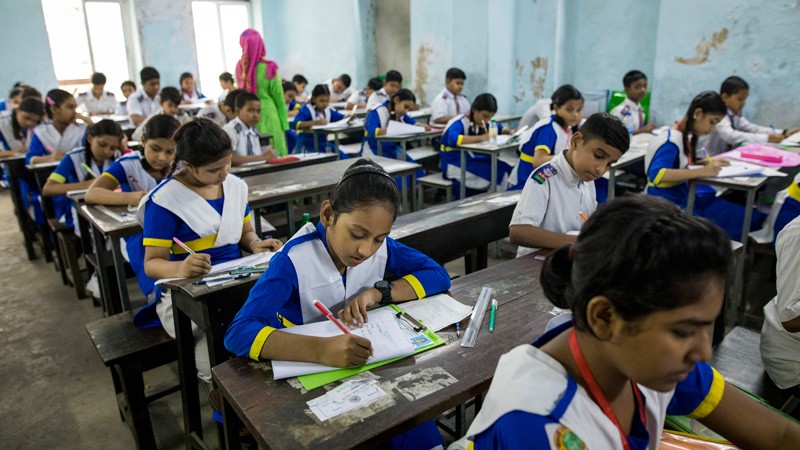每日外闻86
追踪全球教育中的不平等
已经开发出工具来预测到2030年世界各地教育的不平等。它们表明,总体不平等程度将下降,但世界所有地区都无法实现普及中学教育。
受教育年限的延长与健康和生存状况的改善、人口增长的放缓和经济的增长都有关系。由于其重要性,获得包容和公平的优质教育被列入2015年联合国大会批准的可持续发展目标之一。可持续发展目标是计划到2030年实现的一套雄心勃勃的国际发展目标。弗里德曼等人在《自然》(Nature)杂志上撰文指出,尽管大多数国家预计到2030年将实现近乎普及的初等教育,但中学毕业率巨大的地区间差异将持续存在。
该文的作者着手评估各国是否有望在2030年前实现教育的可持续发展目标。他们收集了来自195个国家和地区的3180个具有全国代表性的人口普查和调查数据库。这个数据库是对以前监测教育工作的改进,以前的监测工作要么依赖于单一时间点的反投影数据,要么依赖于来自五分之一数据源派生的数据库。弗里德曼等人开发了一个模型,该模型将数据集中的所有数据源结合起来,并根据1970年至2018年期间所有人口的受教育程度(分别按性别和国家)来推断。然后,该模型利用这些信息来预测个别国家或地区、以及作者选择的七个主要世界地区(包括高收入国家、撒哈拉以南非洲、东欧和中亚)未来的教育普及趋势。
—
弗里德曼和他的同事们的研究结论表明:大多数国家到2030年都可以实现几乎全体国民接受小学以上水平的教育(90%以上的儿童都可以读完6年级)。高中教育(12年教育)在各地的进展不均衡,预计到2030年,25岁至29岁的年轻人中只有61%的人完成了高中教育,世界上没有一个主要地区能做到使90%以上的人都接受高中教育。此外,世界上的一些区域接受高等教育(大学)的机会扩大得比其他区域快,所以,预计到2030年,贫富差距将会进一步加大。
男女受教育水平的差异也会进一步缩小,有的地区还将出现女性受教育的年限大大高于男性。
虽然这个研究项目涉及了大量的样本,但该研究仍然还是受到数据量的限制。数据主要还是来源于一些高收入国家,比如法国和德国,就占了一般以上,小的国家和地区的数据占比很小,而且数据大部分是收集于2008年以前。虽然模型已经通过一部分的收集数据进行了拟合评估,但是像马来西亚这种2003年之后的数据缺失的地区,该模型的预测效果不尽如人意。作者利用区域趋势来为缺乏数据的国家或地区提供分析信息,但这种分析结果的可靠性需要谨慎看待。
国家和地区的教育政策也是本模型无法整合预测的,一些国家或地区的免除学费或者增加义务教育年限的政策会使该地区受教育的水平激增。
最终,我们只能监控我们能测量的东西:我们追踪受教育程度和性别差距的趋势,因为这些数据是真实存在的。在大多数的国家和地区,由于社会经济水平不同造成的教育水平的差距要远远大于性别差异,但是关于学生家庭的社会经济水平的数据很少,所以此类研究也受到了数据的限制。同样,近四分之三的国家没有足够的数据来监测学习带来成果(如数学或阅读技能)的进展,而不仅仅是受教育的年限。当我们缺乏适当跟踪进展的数据时,全球对广泛和公平的优质教育的承诺就有可能无法实现其真正目标。
Tracking inequalities in education around the globe
Tools have been developed to project inequalities in education around the world to 2030. They reveal that overall inequality will decline, but that all world regions will fall short of achieving universal secondary education.
Increased years of schooling have been linked to better health and survival, slower population growth and greater economic growth. Because of its importance, access to “inclusive and equitable quality education” was included as one of the Sustainable Development Goals (SDGs) ratified by the United Nations General Assembly in 2015 (see go.nature.com/3ana8ob). The SDGs are an ambitious set of international development targets to be achieved by 2030. Writing in Nature, Friedman et al. provide evidence that, although most nations are projected to achieve near-universal primary education by 2030, large inter-regional disparities in the rates of secondary-school completion will persist.
The authors set out to assess whether countries are on track to achieve the SDGs for education by 2030. They assembled a database of 3,180 nationally representative censuses and surveys from 195 nations and territories. This database is an improvement on previous efforts to monitor education, which relied either on data back-projected from a single time point5 or on a database derived from one-fifth as many data sources6. Friedman et al. developed a model that combines all the data sources in their data set and extrapolates single-year estimates of educational attainment for all populations, separately by sex and country, from 1970 to 2018. The model then uses this information to project future trends in educational attainment for individual countries or territories, and for seven ‘major world regions’ chosen by the authors, which include high-income countries, sub-Saharan Africa and Eastern Europe and central Asia.
Friedman and colleagues conclude that most countries are in line to achieve near-universal levels of primary-school attainment by 2030 — that is, for almost 90% of children to complete 6 years of education (Fig. 1). The exceptions to this trend are places such as Afghanistan, Papua New Guinea and parts of northern sub-Saharan Africa. By contrast, progress towards near-universal secondary attainment (12 years of schooling) is more uneven. Only 61% of young adults aged 25–29 years old are expected to have completed secondary school by 2030, and no major world region is expected to reach near-universal levels of secondary-school attainment. Furthermore, access to tertiary schooling is expanding faster in some world regions than in others; as a result, disparities are expected to increase until 2030.
The authors also find that gaps in educational attainment between men and women are expected to have changed substantially by 2030. In 1970, men achieved significantly more years of education than did women in 142 countries. By 2018, this had narrowed to 27 countries, and by 2030 it is projected to be just 4. Moreover, in 18 nations and regions, women are expected to achieve significantly higher mean years of schooling than men. This changing gap is largely attributable to girls’ gains in primary schooling.
Next, Friedman et al. developed a metric for monitoring educational inequality within countries or territories — average interpersonal difference (AID), which measures the average difference in educational attainment between any two individuals in a population in a given year. The AID provides a different perspective from those of other commonly used metrics.
For example, consider the Gini coefficient, which is perhaps the most commonly used indicator of inequality. Under this coefficient, inequality is highest when education is concentrated in the hands of a few. As access to education expands, the Gini coefficient declines.
By contrast, the AID equates inequality with heterogeneity in educational attainment within a population. When education is concentrated in the hands of the few, the AID is low because most people have the same low level of educational attainment. As access to schooling expands, inequality as measured by the AID rises because the population now contains many people who have no education and many who have several years of schooling. As school enrolment becomes universal and members of the population begin to achieve similarly high levels of education, the AID declines again. From this metric, Friedman and colleagues conclude that global educational inequality peaked in 2017 and is projected to decline until 2030.
Even though this project involves an impressive volume of data, it is still limited by problems of data scarcity. Whereas some high-income countries, such as France and Germany, contribute more than 55 data points to the model, the time series for many resource-constrained and small-population countries or territories are extrapolated from fewer than 5 data points, or rely on data last collected in or before 2008. Although the validity of the model was evaluated by checking how well its predictions matched real data across many simulations in which one subset of data had been removed, there is no way of assessing how well it estimates attainment trajectories for places such as Malaysia, for which no data were available after 2003. The authors leverage regional trends to inform analyses of countries or territories for which data are scarce, but the results should be interpreted with caution.
The smoothed trajectories of predicted change in the study also hide the profound and often sudden impact of education policies on schooling. The authors note nonlinearities in the rates of change consistent with a sudden increase in schooling, which might result from the elimination of school fees or an increase in the years of compulsory schooling. The recent expansion of free secondary education in many lower-income countries has the potential to further advance progress towards the SDG education goals, beyond what is currently predicted by Friedman and colleagues’ model.
Ultimately, we can monitor only what we can measure: we track trends in educational attainment and in gaps between the sexes because those are the data that exist. Socio-economic gaps in schooling are now substantially larger than are gender gaps in most world regions7, but sufficient data on the socio-economic status of students are scarce. Likewise, almost three-quarters of countries have inadequate data with which to monitor progress in learning outcomes (such as mathematics or reading skills), rather than merely in years of schooling (see go.nature.com/39kd4o1). Global commitments to inclusive and equitable quality education run the risk of failing to achieve their true goals when we lack the data to properly track progress.
See you tomorrow











